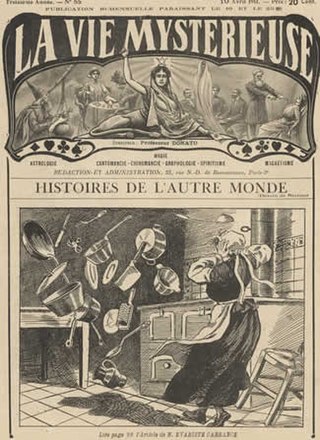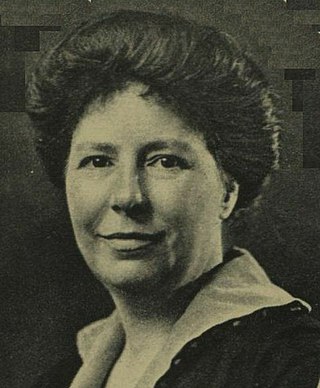
In ghostlore, a poltergeist is a type of ghost or spirit that is responsible for physical disturbances, such as loud noises and objects being moved or destroyed. Most claims or fictional descriptions of poltergeists show them as being capable of pinching, biting, hitting, and tripping people. They are also depicted as capable of the movement or levitation of objects such as furniture and cutlery, or noises such as knocking on doors. Foul smells are also associated with poltergeist occurrences, as well as spontaneous fires and different electrical issues such as flickering lights.

The Society for Psychical Research (SPR) is a nonprofit organisation in the United Kingdom. Its stated purpose is to understand events and abilities commonly described as psychic or paranormal. It describes itself as the "first society to conduct organised scholarly research into human experiences that challenge contemporary scientific models." It does not, however, since its inception in 1882, hold any corporate opinions: SPR members assert a variety of beliefs with regard to the nature of the phenomena studied.

Frederic William Henry Myers was a British poet, classicist, philologist, and a founder of the Society for Psychical Research. Myers' work on psychical research and his ideas about a "subliminal self" were influential in his time, but have not been accepted by the scientific community. However, in 2007 a team of cognitive scientists at University of Virginia School of Medicine, led by Edward F. Kelly published a major empirical-theoretical work, Irreducible Mind, citing various empirical evidence that they think broadly corroborates Myer's conception of human self and its survival of bodily death.
A psychic detective is a person who investigates crimes by using purported paranormal psychic abilities. Examples have included postcognition, psychometry, telepathy, dowsing, clairvoyance, and remote viewing. In murder cases, psychic detectives may purport to be in communication with the spirits of the murder victims.
A debunker is a person or organization that exposes or discredits claims believed to be false, exaggerated, or pretentious. The term is often associated with skeptical investigation of controversial topics such as UFOs, claimed paranormal phenomena, cryptids, conspiracy theories, alternative medicine, religion, or exploratory or fringe areas of scientific or pseudoscientific research.

Within ghost hunting and parapsychology, electronic voice phenomena (EVP) are sounds found on electronic recordings that are interpreted as spirit voices. Parapsychologist Konstantīns Raudive, who popularized the idea in the 1970s, described EVP as typically brief, usually the length of a word or short phrase.
Psychometry, also known as token-object reading, or psychoscopy, is a form of extrasensory perception characterized by the claimed ability to make relevant associations from an object of unknown history by making physical contact with that object. Supporters assert that an object may have an energy field that transfers knowledge regarding that object's history.

The Enfield poltergeist was a claim of supernatural activity at 284 Green Street, a council house in Brimsdown, Enfield, London, England, United Kingdom, between 1977 and 1979. The alleged poltergeist activity centred around sisters Janet (11) and Margaret Hodgson (13). Some members of the Society for Psychical Research (SPR), such as inventor Maurice Grosse and writer Guy Lyon Playfair, believed the haunting to be genuine, while others such as Anita Gregory and John Beloff were "unconvinced" and found evidence the girls had faked incidents for the benefit of journalists. Members of the Committee for the Scientific Investigation of Claims of the Paranormal (CSICOP), including stage magicians such as Milbourne Christopher and Joe Nickell, criticized paranormal investigators for being credulous whilst also identifying elements of the case as being indicative of a hoax.

George Albert Smith was an English stage hypnotist, psychic, magic lantern lecturer, Fellow of the Royal Astronomical Society, inventor and a key member of the loose association of early film pioneers dubbed the Brighton School by French film historian Georges Sadoul. He is best known for his controversial work with Edmund Gurney at the Society for Psychical Research, his short films from 1897 to 1903, which pioneered film editing and close-ups, and his development of the first successful colour film process, Kinemacolor.

The Stone Tape is a 1972 British television horror drama film written by Nigel Kneale and directed by Peter Sasdy and starring Michael Bryant, Jane Asher, Michael Bates and Iain Cuthbertson. It was broadcast on BBC Two as a Christmas ghost story in 1972. Combining aspects of science fiction and horror, the story concerns a team of scientists who move into their new research facility, a renovated Victorian mansion that has a reputation for being haunted. The team investigate the phenomena, trying to determine if the stones of the building are acting as a recording medium for past events. However, their investigations serve only to unleash a darker, more malevolent force.

Thomas Charles Lethbridge, better known as T. C. Lethbridge, was an English archaeologist, parapsychologist, and explorer. A specialist in Anglo-Saxon archaeology, he served as honorary Keeper of Anglo-Saxon Antiquities at the Cambridge University Museum of Archaeology and Ethnology from 1923 to 1957, and over the course of his lifetime wrote twenty-four books on various subjects, becoming particularly well known for his advocacy of dowsing.

Eusapia Palladino was an Italian Spiritualist physical medium. She claimed extraordinary powers such as the ability to levitate tables, communicate with the dead through her spirit guide John King, and to produce other supernatural phenomena.

Ghost hunting is the process of investigating locations that are reported to be haunted by ghosts. Typically, a ghost-hunting team will attempt to collect evidence supporting the existence of paranormal activity. Ghost hunters use a variety of electronic devices, including EMF meters, digital thermometers, both handheld and static digital video cameras, including thermographic and night vision cameras, night vision goggles, as well as digital audio recorders. Other more traditional techniques are also used, such as conducting interviews and researching the history of allegedly haunted sites. Ghost hunters may also refer to themselves as paranormal investigators.

Rudi Schneider, son of Josef Schneider and brother of Willi Schneider, was an Austrian Spiritualist and physical medium. His career was covered extensively by the Journal of the American Society for Psychical Research, and he took part in a number of notable experiments conducted by paranormal researchers/debunkers, including Harry Price, Albert von Schrenck-Notzing and Eric Dingwall. Some of these researchers declared him to be a fraud while others were unable to find evidence of trickery.
Guy Lyon Playfair was a British writer, best known for his books about parapsychology and his investigation of the Enfield poltergeist.

Zachary Alexander Bagans is an American paranormal investigator, actor, television personality, museum operator, and author. He is the principal host of the Travel Channel series Ghost Adventures.

Psychokinesis, or telekinesis, is a hypothetical psychic ability allowing a person to influence a physical system without physical interaction.

The cross-correspondences refers to a series of automatic scripts and trance utterances from a group of automatic writers and mediums, involving members of the Society for Psychical Research (SPR). According to psychical researchers the correspondences when put together convey intelligible messages either from spirits of the dead or telepathy.

Psychic archaeology is a loose collection of practices involving the application of paranormal phenomena to problems in archaeology. It is not considered part of mainstream archaeology, or taught in academic institutions. It is difficult to test scientifically, since archaeological sites are relatively abundant, and all of its verified predictions could have been made via educated guesses.

Henry Gordon was a Canadian author, journalist, magician and skeptic. He was the founder of the Ontario Skeptics and a fellow of the Committee for Skeptical Inquiry (CSI).














